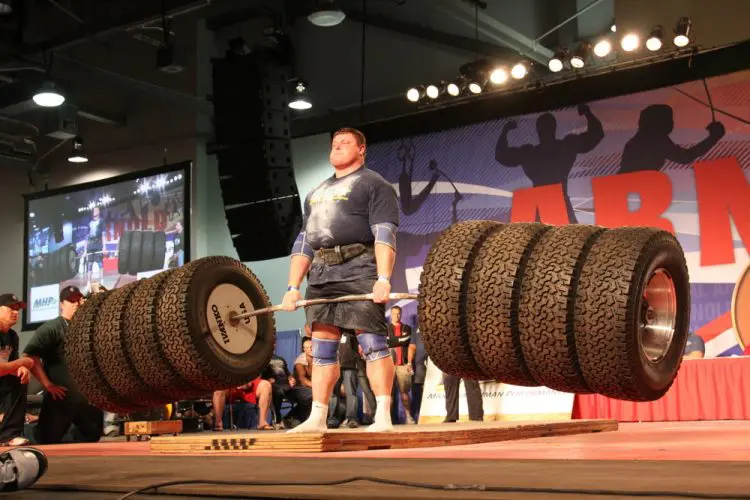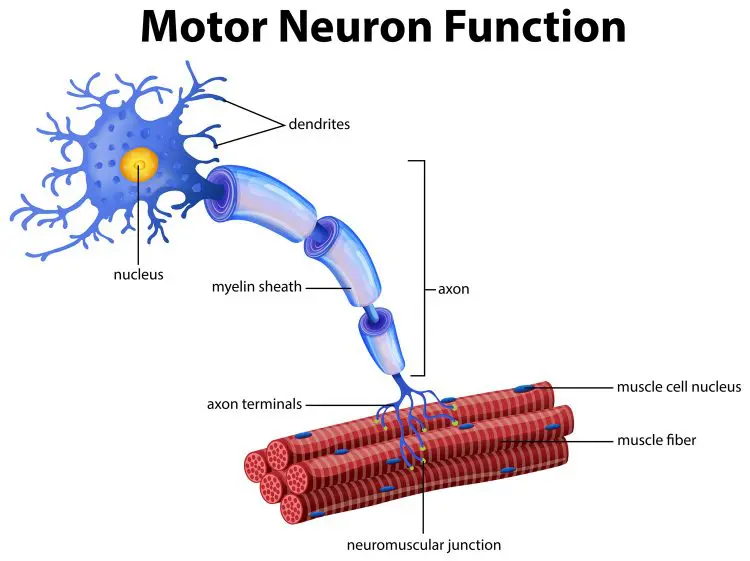If you lift weights – even relatively light ones – you are already increasing your strength. Anything that overloads your muscles and nervous system will make you stronger. However, for a lot of exercisers, increases in strength are a by-product of the type of training they do and not the main goal.
For example, a runner doing lunges will get stronger, even though their training objective is building muscular endurance and balance. Bodybuilders train to build muscle. While they will get stronger, often impressively so, that isn’t the most important part of bodybuilding training.
In contrast, for some exercisers, strength is a priority. They want to get as strong as possible so they can lift the heaviest weights. This includes powerlifters, strongman competitors, Olympic weightlifters, and some athletes too.
You don’t have to be involved in competitions to want to get stronger; for a lot of lifters getting strong and pursuing heavier and heavier weights is a source of great personal satisfaction.

Training for strength can also have some positive effects on your health and quality of life (1). It’s an important fitness component that tends to decline with age, making many everyday tasks harder than they need to be. If you want to age well, you need to get (and stay) strong.
Level Up Your Fitness: Join our 💪 strong community in Fitness Volt Newsletter. Get daily inspiration, expert-backed workouts, nutrition tips, the latest in strength sports, and the support you need to reach your goals. Subscribe for free!
In this guide, we reveal how to increase strength. This is NOT a guide to powerlifting or Olympic lifting. Instead, this information is for the gym-goer who wants to get stronger just for the hell of it!
What is Strength?
Before you jump to the strength program at the end of this article (and we know you’re tempted!), let’s take a moment to examine what strength actually is.
In sports science lingo, strength is your ability to generate force. It’s typically expressed in terms of your one-repetition maximum, or 1RM for short. That means it’s the amount of weight you can lift once, but not twice.
Sports that involve demonstrating strength include powerlifting and Olympic weightlifting. There are also some pure strength events in strongman competitions.
While single-rep lifts are how we test and demonstrate strength, it’s not necessarily the best way to build it. Training with maximal loads is exhausting and takes a lot out of your body and nervous system.
Instead, most strength training involves lifting sub-maximal weights for higher reps – usually no more than 5-6 reps per set. This is best thought of as strength endurance.
While muscle size plays a role in strength, it’s not the only thing that determines how strong you are. Your nervous system plays a critical part too. In fact, it’s entirely possible for a lightly muscled person to be stronger than someone much larger if they train appropriately. That’s why some light and middleweight powerlifters are much, MUCH stronger than far larger bodybuilders.
Your muscles are made up of muscle fibers, and those muscle fibers work in groups called motor units. Each motor unit is controlled by a motor neuron or nerve. Muscles contain anything from just a couple of motor units to over a hundred.
The more motor units you can innervate (or activate) at the same time, the more force you’ll be able to generate.
Think about it like this: Imagine there are two lifters, and both of them weigh 200lbs and have similar-sized muscles. One does a lot of low rep/heavy weight training, while the other tends to do more higher rep/moderate weight training.
The first lifter’s nervous system has been trained to innervate more motor units at the same time and so they can generate more force. The second lifter has plenty of muscle mass, but their nervous system is not so well-tuned and cannot innervate as many motor units simultaneously. They’re still strong but are unable to match the first lifter.
Training for strength will increase your muscle size, but not as dramatically as hypertrophy (bodybuilding) training. Instead, it affects your nervous system as much as your muscular system. Because of this, lifters who want to get strong AND muscular usually combine both types of training and do something commonly called powerbuilding – which is a cross between powerlifting and bodybuilding.
Training to Increase Strength
Any type of strength training will increase your strength, but if you want to get really strong, you need to train in a specific way. There are several essential principles you must adhere to if you’re going to build the sort of strength that will bend bars and turn heads in the gym.
Those principles are:
Weight selection
Lifting light to moderate weights can help you build muscle, but you need to go heavy if you want to get strong. Experts agree that, for increasing strength, you need to train with weights greater than 80% of your 1RM (2). This will trigger the neurological and muscular changes necessary to increase strength.
Reps and Sets
Lifting heavy weights means doing fewer reps. Training for strength typically involves working in the 1-5 rep range. However, single and even two rep sets are usually reserved for very advanced lifters, and when peaking for a competition, e.g., a powerlifting meet. Low reps are often accompanied by a higher number of sets. Some experienced lifters may do as many as ten sets of 2-3 reps per set, but 4-6 sets should suffice for the rest of us.
Recovery Between Sets
A strength training set can take ten seconds or less to complete. After all, you may only be doing a couple of reps. Very little lactic acid is produced during this time, and your heart and breathing rate won’t change much either. Subsequently, you’ll probably feel recovered within a minute or so.
However, your nervous system takes longer to recover than your muscles, and it’s your nervous system that determines how much weight you can lift. If you do your next set too soon, you won’t be able to innervate as many motor units, and you may find that you are unable to lift the weight at all, or you can’t do as many reps.
Because of this, to increase your strength, you need to rest long enough for your muscles AND nervous system to recover between sets. This is usually 3-5 minutes but can be as long as 10-15 minutes if you are working very close to or at your maximum.
You don’t have to be entirely passive during your rest between sets. In fact, this downtime is an ideal opportunity to do some prehab or rehab training or work on your flexibility. However, you do need to stay warm and focused, so you’ll be able to give your next set your best effort.
Exercise Selection
You can build strength with any exercise, providing you can lift heavy enough weights. However, it’s more efficient and effective if you focus on compound exercises.
Compound exercises involve multiple muscles and joints working together. They allow you to lift more weight than isolation exercises, where only one joint is moving, and fewer muscles are involved. More weight means increased nervous system stimulation and, as you know, the nervous system plays a critical role in the development of strength.
Level Up Your Fitness: Join our 💪 strong community in Fitness Volt Newsletter. Get daily inspiration, expert-backed workouts, nutrition tips, the latest in strength sports, and the support you need to reach your goals. Subscribe for free!
If you want to build real strength, you need to focus on a relatively small number of lifts per workout. This could be as few as just 1-2. After all, you’ll potentially be doing a lot of sets and taking long breaks between exercises.
Generally speaking, your strength-building workouts will involve variations of the following:
Between them, these exercises work virtually every major muscle group.
Progression
You are only as strong as your last workout, and if you want to get stronger, you’ll need to train a little harder from one week to the next. You can increase your strength by adding more weight to the bar, or doing more reps, providing you stay in the rep 1-5 rep range. If you can do more than 5-6 reps per set, the weight is probably less than 80% of your 1RM, so too light for maximal strength gains.
As a beginner, you’ll probably find that you can increase your weights in quite big jumps from one week to the next – 5 to 10 pounds, for example. But, as you get stronger, those increases will become smaller, and you’ll have to fight for every extra pound you add to the bar.
Deloading
You can’t train hard and heavy all the time. At some point, the stresses of training will start to outpace your ability to recover, and you’ll need to back off and allow your body to rest and adapt. Because of this, a lot of lifters use deload periods. This involves either a break from training or a week or so of easier workouts. Learn more about this topic in our guide to deloading.
Think movements, and not muscles – bodybuilders use split routines to train different muscles on different days. For example:
- Monday – chest, and triceps
- Tuesday – back and biceps
- Wednesday – rest
- Thursday – legs, and calves
- Friday – shoulders, and abs
- Saturday and Sunday – rest
For building strength, workouts should focus more on movements or specific exercises than individual muscles. For example:
- Monday – squats, and assistance exercises
- Tuesday – rest
- Wednesday – bench press and assistance exercises
- Friday – rest
- Friday – deadlift and assistance exercises
- Saturday and Sunday – rest
What are assistance exercises? Keep reading…!
Use Assistance Exercises
Assistance exercises are movements that won’t directly increase strength but can still make you stronger. For example, if you struggle to lock out fully during bench presses, you may have underdeveloped triceps. So, to remedy this, you’d do extra triceps training to fix this weak link.

Assistance exercises can also help plug any developmental gaps that could lead to injury. If your upper back is weak, you run the risk of developing poor posture and shoulder pain, so you might include exercises like face pulls and band pull-aparts in your workouts.
Assistance exercises are generally done using lighter weights, higher reps, and fewer sets than your main strength-building activities. They are supplementary to the main lifts. If you are tired, you may even choose to drop your assistance exercises from your program, so you can focus 100% on your main lifts. However, if this becomes a regular occurrence, you may need to start paying more attention to recovery.
Lift Fast
Heavy weights don’t tend to move very quickly. However, for maximum training effect, you should always TRY to lift them fast. This intent will increase nervous system activation so you can move more weight or do more reps. Because of this, you need to lift aggressively.
Forget about tempo training and time under tension. Instead, lower under control and then explode. The weight won’t move quickly, but you should always lift it as if it would.
Using this information, you should be able to create your own basic strength training workout. But, to save you the trouble, we’ve made one for you.
How to Increase Your Strength: Sample Workout
Before starting this or any other workout, you must warm up properly. This will prepare your muscles and joints for what you are about to do and may also reduce your risk of injury.
Do 5-10 minutes of easy cardio to raise your core temperature, and then do some dynamic mobility and flexibility exercises for the body parts you are about to train.
Lastly, do a few sets of the main exercises you are about to perform, starting light, and increasing the load set by set until you reach your training weight. This will fire up your all-important nervous system and provide you with the opportunity to practice and perfect your technique. This is called ramping.
For example, if your workout calls for four sets of four reps with 100kg, your warm-up could look like this:
- 10 reps x 20kg (empty barbell)
- 8 reps x 40kg
- 5 reps x 60kg
- 3 reps x 80kg
- 4 reps x 100kg (1st work set)
Note how the reps decrease as the weight increases. This allows you to become accustomed to the load without tiring yourself out. The heavier your training weights are, the more ramping sets you’ll need to perform.
This routine involves four training days. Each workout is built around 1-2 core lifts and a couple of assistance exercises.
Weekly split:
| Mon | Tue | Wed | Thu | Fri | Sat | Sun |
| Squat | Bench press | Rest | Deadlift | Rest | Overhead press | Rest |
| Squat & assistance | ||||
| Exercise | Sets | Reps | Recovery | |
| 1 | Back squat | 6 | 3 | 3-5 minutes |
| 2 | Romanian deadlift | 4 | 6 | 2-3 minutes |
| 3 | Front squat | 4 | 6 | 2-3 minutes |
| 4 | Leg curls | 3 | 12 | 90 seconds |
| 5 | Standing calf raises | 3 | 12 | 90 seconds |
| 6 | Rollouts | 3 | 12 | 90 seconds |
| Bench press & assistance | ||||
| Exercise | Sets | Reps | Recovery | |
| 1 | Barbell bench press | 6 | 3 | 3-5 minutes |
| 2 | Bent over rows | 4 | 6 | 2-3 minutes |
| 3 | Close grip bench press | 4 | 6 | 2-3 minutes |
| 4 | Face pulls | 3 | 12 | 90 seconds |
| 5 | Skull crushers | 3 | 12 | 90 seconds |
| 6 | Triceps pushdowns | 3 | 12 | 90 seconds |
| Deadlift & assistance | ||||
| Exercise | Sets | Reps | Recovery | |
| 1 | Deadlift | 6 | 3 | 3-5 minutes |
| 2 | Leg press | 4 | 8 | 2-3 minutes |
| 3 | Rack pulls | 4 | 6 | 2-3 minutes |
| 4 | Leg extension | 3 | 12 | 90 seconds |
| 5 | Seated calf raises | 3 | 12 | 90 seconds |
| 6 | Shovel lifts | 3 | 6 | 90 seconds |
| Overhead press & assistance | ||||
| Exercise | Sets | Reps | Recovery | |
| 1 | Barbell overhead press | 6 | 3 | 3-5 minutes |
| 2 | Pull-ups (weighted) | 4 | 6 | 2-3 minutes |
| 3 | Dumbbell shoulder press | 4 | 8 | 2-3 minutes |
| 4 | Lat pulldowns | 3 | 12 | 90 seconds |
| 5 | Barbell curls | 3 | 12 | 90 seconds |
| 6 | Reverse curls | 3 | 12 | 90 seconds |
How to Increase Strength – Wrapping Up
Training for strength is a relatively simple process. Focus almost exclusively on big, compound exercises, lift heavy weights for low reps, and take long rests between sets to allow your muscles AND nervous system to recover. Think more about movements than you do muscles and plug any developmental gaps with a few assistance exercises.
But simple doesn’t mean easy!
Training for strength requires a willingness to push yourself to the limit. Easy workouts won’t make you stronger. If you aren’t nervous going into a heavy strength training workout, you probably aren’t training hard or heavy enough. Or, maybe you aren’t showing the weights the respect they deserve.
To gain strength, you can’t just show up and pump out a few reps of curls or calf raises. Instead, you need to focus your mind on what you are about to do. You need determination and aggression too. Those heavy weights don’t want to move, and it’s your job to convince them otherwise.
But, despite (or even because) of all this hard work, it’s a huge buzz to see more and more plates on the bar. Increasing your strength could be one of the most rewarding ways to spend your gym time.
References:
1 – PubMed: Resistance Training Is Medicine: Effects of Strength Training on Health https://pubmed.ncbi.nlm.nih.gov/22777332/
2 – Frontiers in Physiology: Greater Neural Adaptations following High- vs. Low-Load Resistance Training https://www.frontiersin.org/articles/10.3389/fphys.2017.00331/full















